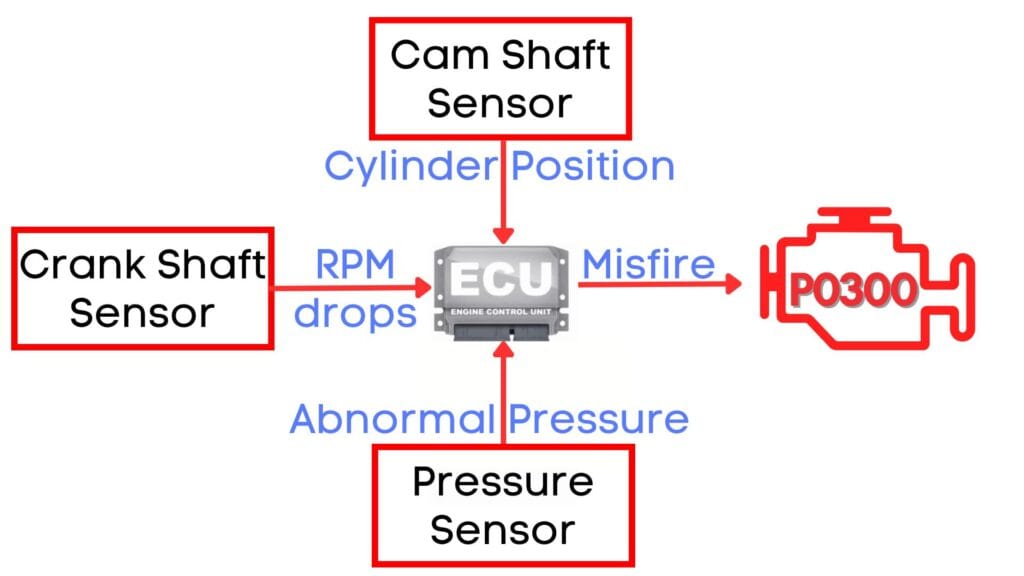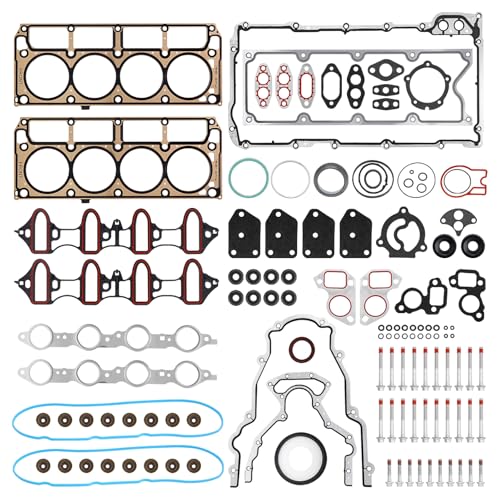How To Fix P0300? | Random or Multiple Cylinder Misfire Detected
When you purchase through links on our site, we may earn an affiliate commission. See our affiliate disclaimer for more information.
What does the P0300 Random or Multiple Cylinder Misfire Detected mean?
P0300 code gets triggered when the Engine Control Module detects an engine misfire that’s either random or showing up on multiple cylinders.
Misfire means that the combustion process inside one or more cylinders isn’t happening properly.
You may also find another OBD-II code, like P0301 to P0308, alongside P0300.
The last number in these accompanying codes refers to the affected cylinder.
When the P0300 Triggers?
The Engine Control Unit, or ECU, monitors the signals from the crankshaft position sensor, camshaft position sensor, and cylinder pressure sensor. These sensors provide real-time data about your engine’s performance.
When a misfire occurs in one or more cylinders, it causes the engine’s RPM to drop abruptly. Simultaneously, the pressure inside the cylinder becomes abnormal. This sudden change in signals from the sensors is what the ECU reads as a misfire.
The camshaft position sensor, on the other hand, helps the ECU determine which specific cylinder is experiencing the misfire.

Why Misfires Take Place?
For proper combustion, three things must be just right: the air-fuel ratio, the spark, and the timing of ignition. If anything disrupts the air, fuel, or spark, it can trigger a misfire.
Some factors that can affect the air, fuel, or spark.
1. Vacuum Leaks
A vacuum leak allows unmetered air to enter the engine. This extra air throws off the air-fuel ratio, causing the mixture to run too lean, which leads to misfires.
Some common locations for vacuum leaks include a torn vacuum hose, a stuck-open PCV valve, a leaking intake manifold gasket, or anything torn in the air intake system after the MAP sensor.
You can use a smoke machine (leak tester) to safely detect leaks in the intake or vacuum system.
- HyperSmoke Technology – Creates Thick Visible Smoke for Easy Leak Testing. Adjustable Pressure. Infinite Smoke. Instant …
- HyperSmoke Benefits – Hypersmoke never overheats, has EVAP mode to protect EVAP from permanent damage, has a mode with h…
- Includes Everything You Need – Made for ALL Leak Testing Scenarios – EVAP, Vacuum, Intake, Exhaust, Turbo, Superchargers…
2. Dirty Throttle Plate
The throttle plate controls the amount of air entering the combustion chambers. If it’s dirty, it can restrict the airflow, disrupting the air-fuel ratio. This disruption can confuse the ECU, causing it to flag a misfire.
You can use a throttle body cleaner to carefully clean the throttle plate and restore smooth airflow.
- Quickly and safely removes accumulated deposits
- Improves air flow
- Restores air fuel ratio
3. Torn Head Gasket
A torn head gasket can allow unwanted air, oil, or coolant to leak into the combustion chamber. This disrupts the air-fuel mixture and prevents proper ignition.
If the gasket is compromised, your engine might struggle to ignite the air-fuel mixture, leading to misfires.
- FITMENT1: 5.3 full head gasket compatible with Chevy: 2007-2013 Avalanche | 2007 Silverado 1500 Classic | 2005-2013 Silv…
- FITMENT2: 5.3 full head gasket compatible with GMC: 2005-2009 Envoy Xuv, XL | 2005-2013 Sierra 1500 | 2010-2013 Sierra |…
- PACKAGE INCLUDES: 5.3 gasket set includes multiple layers steel head gaskets, 30 pcs ES72220 cylinder head bolts, rear c…
4. Dirty MAF Sensor
A dirty MAF sensor can mislead your Engine Control Module, or ECM, by giving it inaccurate readings of the airflow entering the engine.
If the readings are off, the ECM will command the wrong amount of fuel. This throws off the air-fuel ratio, which can cause engine misfires
- Genuine part that fits your specific vehicle
- Manufactured to meet specifications for fit, form and function
- Specially developed micromechanical sensor element design: For precise measurement
5. Faulty Oxygen Sensor
Cracks or leaks in the exhaust manifold, catalytic converter, muffler, or exhaust pipe can lead to incorrect sensor readings.
If the oxygen sensor is faulty, it can send incorrect data, leading the ECM to miscalculate the air-fuel ratio. This imbalance can result in engine misfires.
- 【REPLACE#】15716, 15717, 15718, 15719, ZZC318861, XR3Z9G444CA, 15664, 234-4401, 234-4046. IF THE PLUG OF THE O2 SENSOR IS…
- 【REPLACEMENT FOR】2003-2014 Ford E150 E250 | 1999-2016 Ford E350 Super Duty | 2001-2010 Ford Escape | 1997-2011 Ford Expe…
- 【12-MONTH WARRANTY】If for any reason at all, you are not fully satisfied with the upstream downstream oxygen sensor, sim…
6. Faulty Camshaft or Crankshaft Sensors
Delayed ignition timing can increase emissions and reduce the effectiveness of the catalytic converter.
These sensors are crucial because they help the ECM time the spark correctly to ignite the air-fuel mixture. If they start to fail or go intermittent, it can throw off the timing, leading to poor combustion.
- [Vehicle Fitment-1]: Compatible with Infiniti FX35 2003-2008 V6 3.5L, G35 2003-2007 V6 3.5L, I35 2002-2004 V6 3.5L, M35 …
- [Vehicle Fitment-2]: Compatible with Nissan 350Z 2003-2006 V6 3.5L, Altima 2002-2006 V6 3.5L, Maxima 2002-2008 V6 3.5L, …
- [Reference Number]: Bank 1 Sensor: 907-716, 907716, 237315M010, 237315M015, 237315M016, 237316J900, 237316J905, 237316J9…
7. Faulty Fuel Pressure Regulator
The fuel pressure regulator is responsible for maintaining the right pressure in the fuel system, ensuring that the fuel is delivered properly to the engine.
- Base pressure adjustable from 30-70 psi
- Fuel pressure rises on a 1:1 ratio with boost
- Provides (2) ORB-06 inlet/outlet ports and (1) ORB-06 return port
8. Bad Fuel Pump
The fuel pump is responsible for delivering fuel from the tank to the engine. But when it starts to go bad, it won’t be able to keep up with the engine’s fuel demands.
This lack of proper fuel pressure will throw off the air-fuel ratio, disrupting the combustion process and potentially triggering the P0300 code for random misfires.
- 【Replacement Part Number】Electric Fuel Pump Module fits for 5136023,5136022,5136023AC,5136023AA,05136023AB,05136023AA,51…
- 【Compatible with】Electric Fuel Pump Module fits for 2005-2015 Chrysler 300,2008-2015 Dodge Challenger,2006-2015 Dodge Ch…
- 【Higher Quality】Made of High Quality & Durable Materials,factory after strict inspection,meet or reach the OE standard,t…
9. Clogged or Faulty Fuel Injectors
A faulty injector may not deliver enough fuel or could leak fuel, causing an incorrect air-fuel ratio and misfires.
- [Vehicle Fitment-1]: Compatible with Jeep Grand Cherokee 2011-2015, Wrangler 2012-2017; Compatible with Ram 1500 2013-20…
- [Vehicle Fitment-2]: Compatible with Chrysler 200 2011-2017, 300 2011-2019, Town & Country 2011-2016; Compatible with Do…
- [Reference Number]: 800-2183N, 8002183N, 5184085AD, 05184085AC, 4G2269, 0280158233, FJ1147
10. Spark Plugs and Ignition Coils
A faulty injector may not deliver enough fuel or could leak fuel, causing an incorrect air-fuel ratio and misfires.
- 4 pack NGK Laser Iridium 92145 Spark Plug
- Genuine NGK Parts
- Includes original packaging and hardware
11. Loose Timing Chain or Timing Belt
The timing chain or belt ensures that the intake and exhaust valves open and close at the precise time in sync with the engine’s pistons. If the chain or belt becomes loose or jumps a tooth on one of the sprockets, it can throw off the timing.
- 【Part Number】14510-R40-A01, 13620-RAA-A02, 14210-PNA-000, 14530-PPA-003, 14530-RAA-A01, 14530-RZA-A01, 14540-RWC-A02, 14…
- 【Compatible With】For Honda Acura ILX Accord Civic Crosstour CR-V 2.4L 2008-2015. Please read our descriptions and pictur…
- 【Powerful Function】Our timing chain kits feature advanced design and vibration reduction technology to reduce friction a…











